The School Welfare Officer's Role in Assessing Asma's Wellbeing
VerifiedAdded on 2023/05/30
|9
|1705
|257
Report
AI Summary
This report delves into the responsibilities of a school welfare officer, particularly in the context of the Younis family case study, where the officer is tasked with assessing Asma's wellbeing through the lens of her education. The assignment highlights the officer's role in providing support, implementing intervention strategies, and collaborating with multidisciplinary teams to address Asma's challenges, which include unexplained absences from school. The report emphasizes the importance of primary prevention strategies, integrated family support, and the need for tailored interventions based on comprehensive assessments. It underscores the officer's role in coordinating services, promoting student attendance, and fostering a supportive school environment that considers the diverse needs of all students. The report outlines policies and procedures to enhance student wellbeing, including the implementation of comprehensive curricula, promoting mutual respect, and establishing effective communication channels with parents and the community. The officer's responsibilities also include coordinating support for families, identifying risks, and developing evidence-based programs to improve student outcomes. The ultimate goal is to create a holistic and integrated service provision to support Asma and other students.
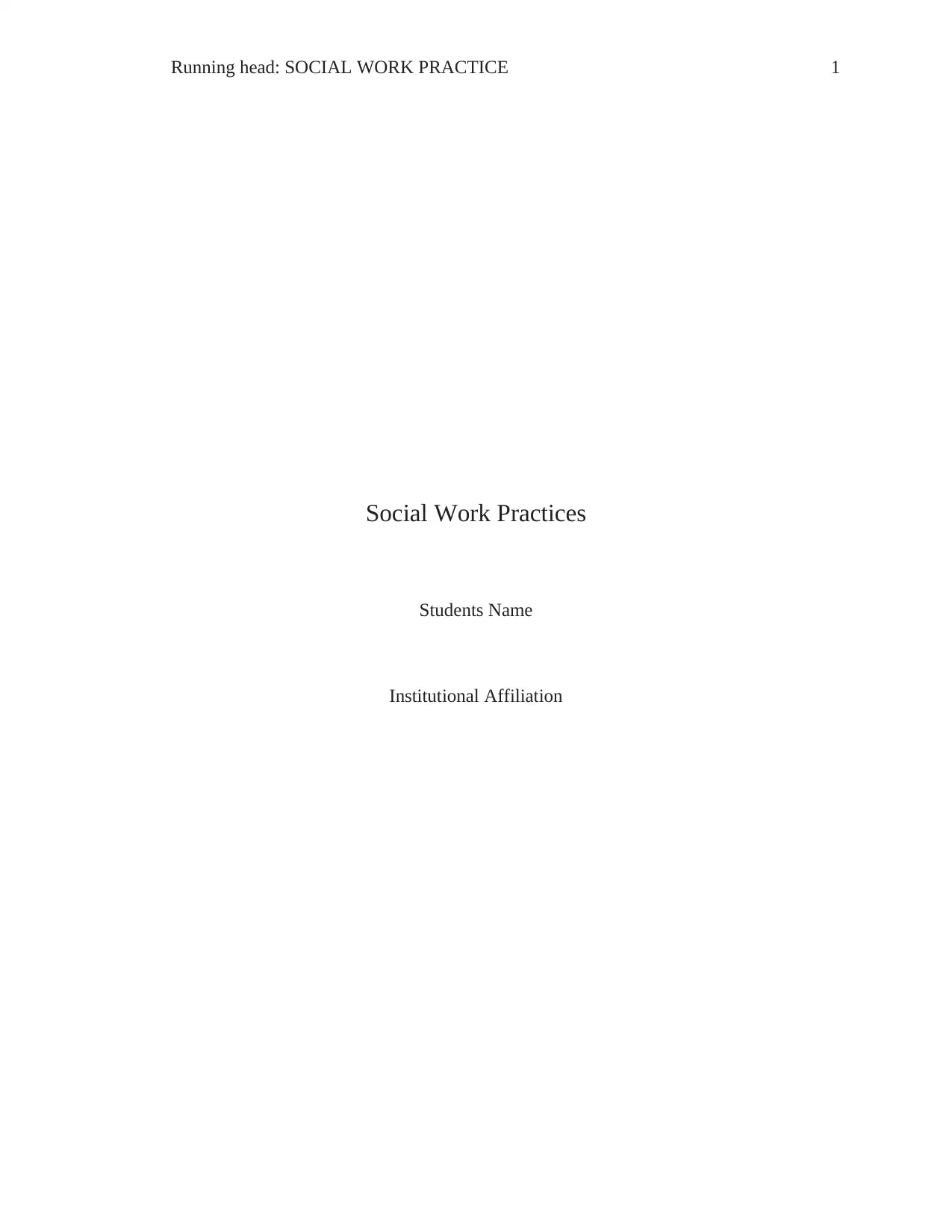
Running head: SOCIAL WORK PRACTICE 1
Social Work Practices
Students Name
Institutional Affiliation
Social Work Practices
Students Name
Institutional Affiliation
Paraphrase This Document
Need a fresh take? Get an instant paraphrase of this document with our AI Paraphraser
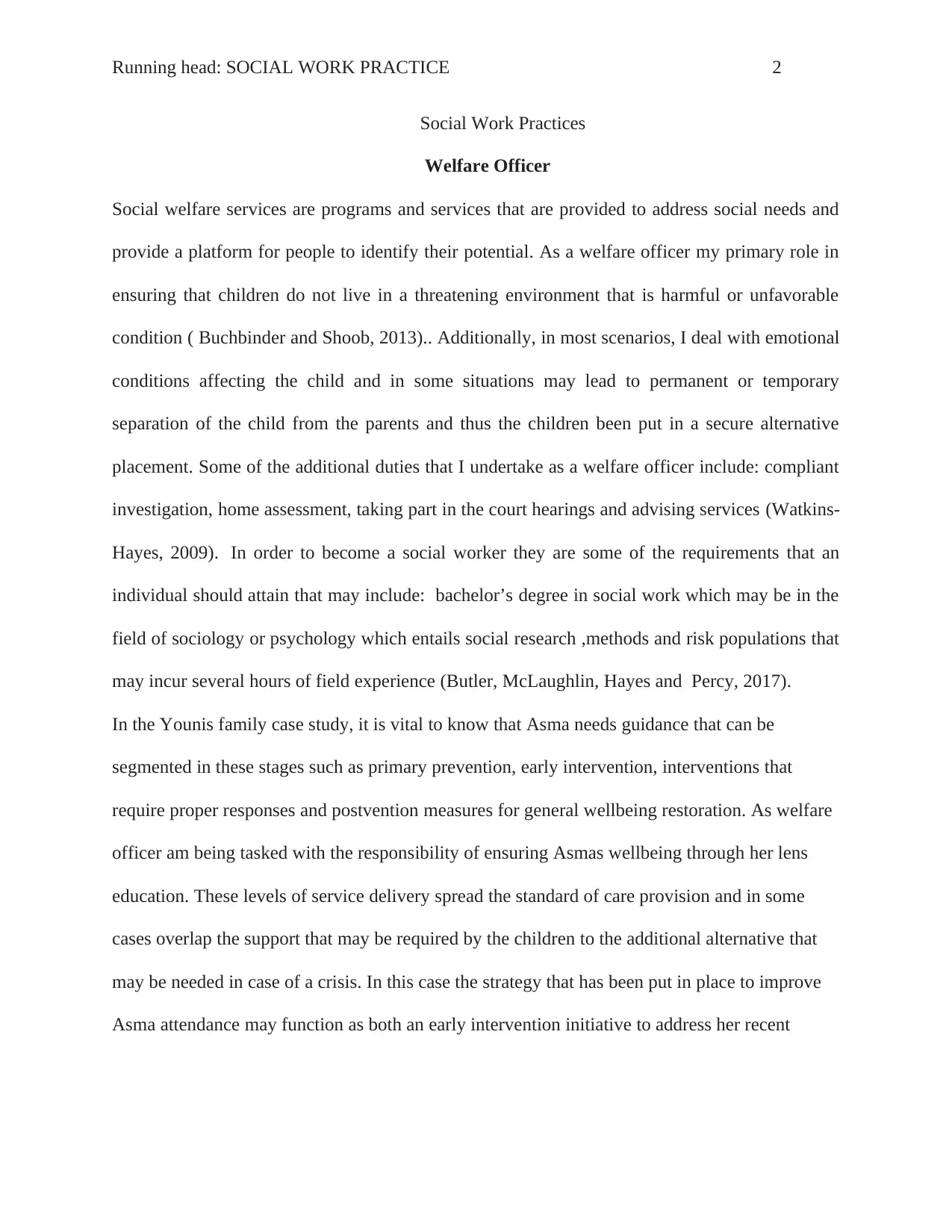
Running head: SOCIAL WORK PRACTICE 2
Social Work Practices
Welfare Officer
Social welfare services are programs and services that are provided to address social needs and
provide a platform for people to identify their potential. As a welfare officer my primary role in
ensuring that children do not live in a threatening environment that is harmful or unfavorable
condition ( Buchbinder and Shoob, 2013).. Additionally, in most scenarios, I deal with emotional
conditions affecting the child and in some situations may lead to permanent or temporary
separation of the child from the parents and thus the children been put in a secure alternative
placement. Some of the additional duties that I undertake as a welfare officer include: compliant
investigation, home assessment, taking part in the court hearings and advising services (Watkins-
Hayes, 2009). In order to become a social worker they are some of the requirements that an
individual should attain that may include: bachelor’s degree in social work which may be in the
field of sociology or psychology which entails social research ,methods and risk populations that
may incur several hours of field experience (Butler, McLaughlin, Hayes and Percy, 2017).
In the Younis family case study, it is vital to know that Asma needs guidance that can be
segmented in these stages such as primary prevention, early intervention, interventions that
require proper responses and postvention measures for general wellbeing restoration. As welfare
officer am being tasked with the responsibility of ensuring Asmas wellbeing through her lens
education. These levels of service delivery spread the standard of care provision and in some
cases overlap the support that may be required by the children to the additional alternative that
may be needed in case of a crisis. In this case the strategy that has been put in place to improve
Asma attendance may function as both an early intervention initiative to address her recent
Social Work Practices
Welfare Officer
Social welfare services are programs and services that are provided to address social needs and
provide a platform for people to identify their potential. As a welfare officer my primary role in
ensuring that children do not live in a threatening environment that is harmful or unfavorable
condition ( Buchbinder and Shoob, 2013).. Additionally, in most scenarios, I deal with emotional
conditions affecting the child and in some situations may lead to permanent or temporary
separation of the child from the parents and thus the children been put in a secure alternative
placement. Some of the additional duties that I undertake as a welfare officer include: compliant
investigation, home assessment, taking part in the court hearings and advising services (Watkins-
Hayes, 2009). In order to become a social worker they are some of the requirements that an
individual should attain that may include: bachelor’s degree in social work which may be in the
field of sociology or psychology which entails social research ,methods and risk populations that
may incur several hours of field experience (Butler, McLaughlin, Hayes and Percy, 2017).
In the Younis family case study, it is vital to know that Asma needs guidance that can be
segmented in these stages such as primary prevention, early intervention, interventions that
require proper responses and postvention measures for general wellbeing restoration. As welfare
officer am being tasked with the responsibility of ensuring Asmas wellbeing through her lens
education. These levels of service delivery spread the standard of care provision and in some
cases overlap the support that may be required by the children to the additional alternative that
may be needed in case of a crisis. In this case the strategy that has been put in place to improve
Asma attendance may function as both an early intervention initiative to address her recent
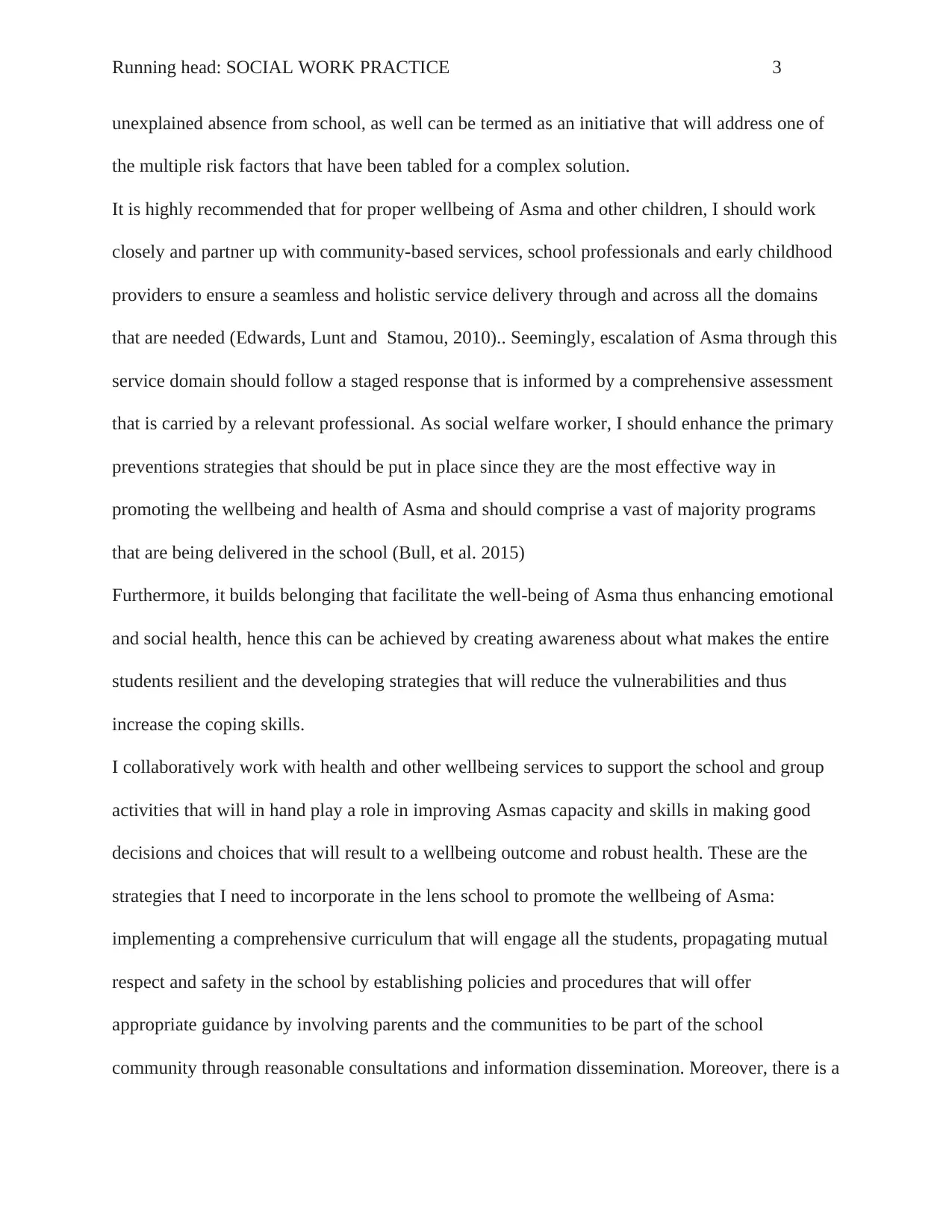
Running head: SOCIAL WORK PRACTICE 3
unexplained absence from school, as well can be termed as an initiative that will address one of
the multiple risk factors that have been tabled for a complex solution.
It is highly recommended that for proper wellbeing of Asma and other children, I should work
closely and partner up with community-based services, school professionals and early childhood
providers to ensure a seamless and holistic service delivery through and across all the domains
that are needed (Edwards, Lunt and Stamou, 2010).. Seemingly, escalation of Asma through this
service domain should follow a staged response that is informed by a comprehensive assessment
that is carried by a relevant professional. As social welfare worker, I should enhance the primary
preventions strategies that should be put in place since they are the most effective way in
promoting the wellbeing and health of Asma and should comprise a vast of majority programs
that are being delivered in the school (Bull, et al. 2015)
Furthermore, it builds belonging that facilitate the well-being of Asma thus enhancing emotional
and social health, hence this can be achieved by creating awareness about what makes the entire
students resilient and the developing strategies that will reduce the vulnerabilities and thus
increase the coping skills.
I collaboratively work with health and other wellbeing services to support the school and group
activities that will in hand play a role in improving Asmas capacity and skills in making good
decisions and choices that will result to a wellbeing outcome and robust health. These are the
strategies that I need to incorporate in the lens school to promote the wellbeing of Asma:
implementing a comprehensive curriculum that will engage all the students, propagating mutual
respect and safety in the school by establishing policies and procedures that will offer
appropriate guidance by involving parents and the communities to be part of the school
community through reasonable consultations and information dissemination. Moreover, there is a
unexplained absence from school, as well can be termed as an initiative that will address one of
the multiple risk factors that have been tabled for a complex solution.
It is highly recommended that for proper wellbeing of Asma and other children, I should work
closely and partner up with community-based services, school professionals and early childhood
providers to ensure a seamless and holistic service delivery through and across all the domains
that are needed (Edwards, Lunt and Stamou, 2010).. Seemingly, escalation of Asma through this
service domain should follow a staged response that is informed by a comprehensive assessment
that is carried by a relevant professional. As social welfare worker, I should enhance the primary
preventions strategies that should be put in place since they are the most effective way in
promoting the wellbeing and health of Asma and should comprise a vast of majority programs
that are being delivered in the school (Bull, et al. 2015)
Furthermore, it builds belonging that facilitate the well-being of Asma thus enhancing emotional
and social health, hence this can be achieved by creating awareness about what makes the entire
students resilient and the developing strategies that will reduce the vulnerabilities and thus
increase the coping skills.
I collaboratively work with health and other wellbeing services to support the school and group
activities that will in hand play a role in improving Asmas capacity and skills in making good
decisions and choices that will result to a wellbeing outcome and robust health. These are the
strategies that I need to incorporate in the lens school to promote the wellbeing of Asma:
implementing a comprehensive curriculum that will engage all the students, propagating mutual
respect and safety in the school by establishing policies and procedures that will offer
appropriate guidance by involving parents and the communities to be part of the school
community through reasonable consultations and information dissemination. Moreover, there is a
⊘ This is a preview!⊘
Do you want full access?
Subscribe today to unlock all pages.

Trusted by 1+ million students worldwide
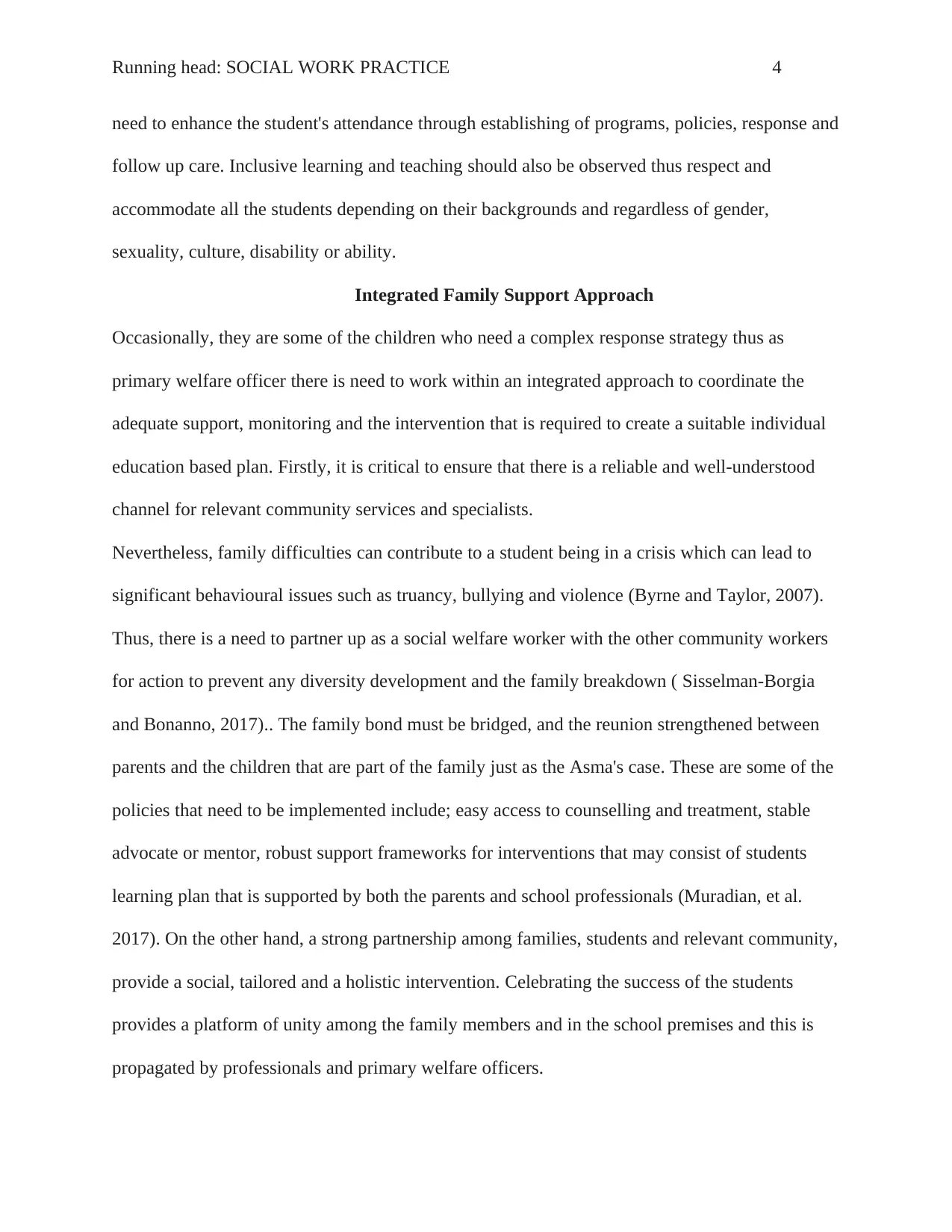
Running head: SOCIAL WORK PRACTICE 4
need to enhance the student's attendance through establishing of programs, policies, response and
follow up care. Inclusive learning and teaching should also be observed thus respect and
accommodate all the students depending on their backgrounds and regardless of gender,
sexuality, culture, disability or ability.
Integrated Family Support Approach
Occasionally, they are some of the children who need a complex response strategy thus as
primary welfare officer there is need to work within an integrated approach to coordinate the
adequate support, monitoring and the intervention that is required to create a suitable individual
education based plan. Firstly, it is critical to ensure that there is a reliable and well-understood
channel for relevant community services and specialists.
Nevertheless, family difficulties can contribute to a student being in a crisis which can lead to
significant behavioural issues such as truancy, bullying and violence (Byrne and Taylor, 2007).
Thus, there is a need to partner up as a social welfare worker with the other community workers
for action to prevent any diversity development and the family breakdown ( Sisselman-Borgia
and Bonanno, 2017).. The family bond must be bridged, and the reunion strengthened between
parents and the children that are part of the family just as the Asma's case. These are some of the
policies that need to be implemented include; easy access to counselling and treatment, stable
advocate or mentor, robust support frameworks for interventions that may consist of students
learning plan that is supported by both the parents and school professionals (Muradian, et al.
2017). On the other hand, a strong partnership among families, students and relevant community,
provide a social, tailored and a holistic intervention. Celebrating the success of the students
provides a platform of unity among the family members and in the school premises and this is
propagated by professionals and primary welfare officers.
need to enhance the student's attendance through establishing of programs, policies, response and
follow up care. Inclusive learning and teaching should also be observed thus respect and
accommodate all the students depending on their backgrounds and regardless of gender,
sexuality, culture, disability or ability.
Integrated Family Support Approach
Occasionally, they are some of the children who need a complex response strategy thus as
primary welfare officer there is need to work within an integrated approach to coordinate the
adequate support, monitoring and the intervention that is required to create a suitable individual
education based plan. Firstly, it is critical to ensure that there is a reliable and well-understood
channel for relevant community services and specialists.
Nevertheless, family difficulties can contribute to a student being in a crisis which can lead to
significant behavioural issues such as truancy, bullying and violence (Byrne and Taylor, 2007).
Thus, there is a need to partner up as a social welfare worker with the other community workers
for action to prevent any diversity development and the family breakdown ( Sisselman-Borgia
and Bonanno, 2017).. The family bond must be bridged, and the reunion strengthened between
parents and the children that are part of the family just as the Asma's case. These are some of the
policies that need to be implemented include; easy access to counselling and treatment, stable
advocate or mentor, robust support frameworks for interventions that may consist of students
learning plan that is supported by both the parents and school professionals (Muradian, et al.
2017). On the other hand, a strong partnership among families, students and relevant community,
provide a social, tailored and a holistic intervention. Celebrating the success of the students
provides a platform of unity among the family members and in the school premises and this is
propagated by professionals and primary welfare officers.
Paraphrase This Document
Need a fresh take? Get an instant paraphrase of this document with our AI Paraphraser
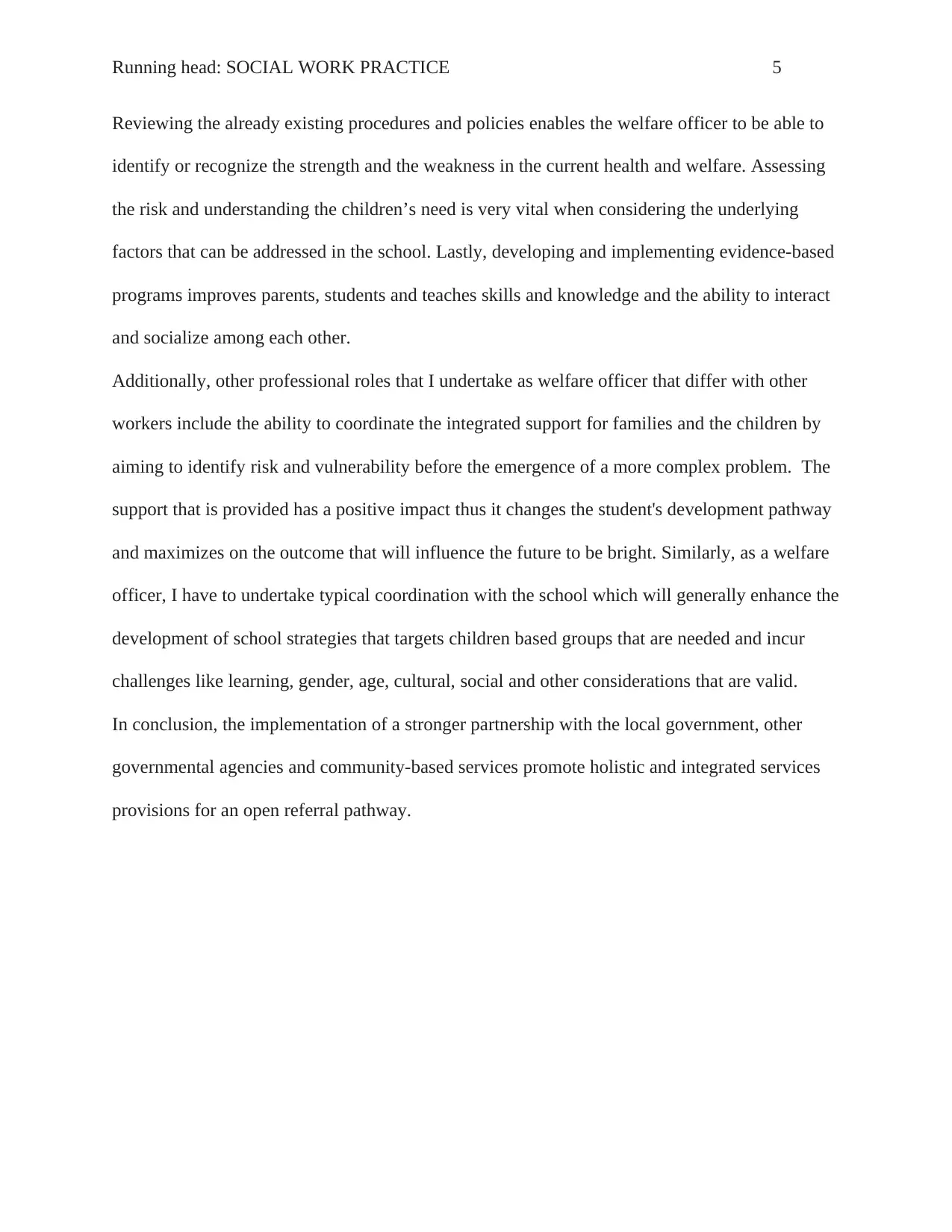
Running head: SOCIAL WORK PRACTICE 5
Reviewing the already existing procedures and policies enables the welfare officer to be able to
identify or recognize the strength and the weakness in the current health and welfare. Assessing
the risk and understanding the children’s need is very vital when considering the underlying
factors that can be addressed in the school. Lastly, developing and implementing evidence-based
programs improves parents, students and teaches skills and knowledge and the ability to interact
and socialize among each other.
Additionally, other professional roles that I undertake as welfare officer that differ with other
workers include the ability to coordinate the integrated support for families and the children by
aiming to identify risk and vulnerability before the emergence of a more complex problem. The
support that is provided has a positive impact thus it changes the student's development pathway
and maximizes on the outcome that will influence the future to be bright. Similarly, as a welfare
officer, I have to undertake typical coordination with the school which will generally enhance the
development of school strategies that targets children based groups that are needed and incur
challenges like learning, gender, age, cultural, social and other considerations that are valid.
In conclusion, the implementation of a stronger partnership with the local government, other
governmental agencies and community-based services promote holistic and integrated services
provisions for an open referral pathway.
Reviewing the already existing procedures and policies enables the welfare officer to be able to
identify or recognize the strength and the weakness in the current health and welfare. Assessing
the risk and understanding the children’s need is very vital when considering the underlying
factors that can be addressed in the school. Lastly, developing and implementing evidence-based
programs improves parents, students and teaches skills and knowledge and the ability to interact
and socialize among each other.
Additionally, other professional roles that I undertake as welfare officer that differ with other
workers include the ability to coordinate the integrated support for families and the children by
aiming to identify risk and vulnerability before the emergence of a more complex problem. The
support that is provided has a positive impact thus it changes the student's development pathway
and maximizes on the outcome that will influence the future to be bright. Similarly, as a welfare
officer, I have to undertake typical coordination with the school which will generally enhance the
development of school strategies that targets children based groups that are needed and incur
challenges like learning, gender, age, cultural, social and other considerations that are valid.
In conclusion, the implementation of a stronger partnership with the local government, other
governmental agencies and community-based services promote holistic and integrated services
provisions for an open referral pathway.
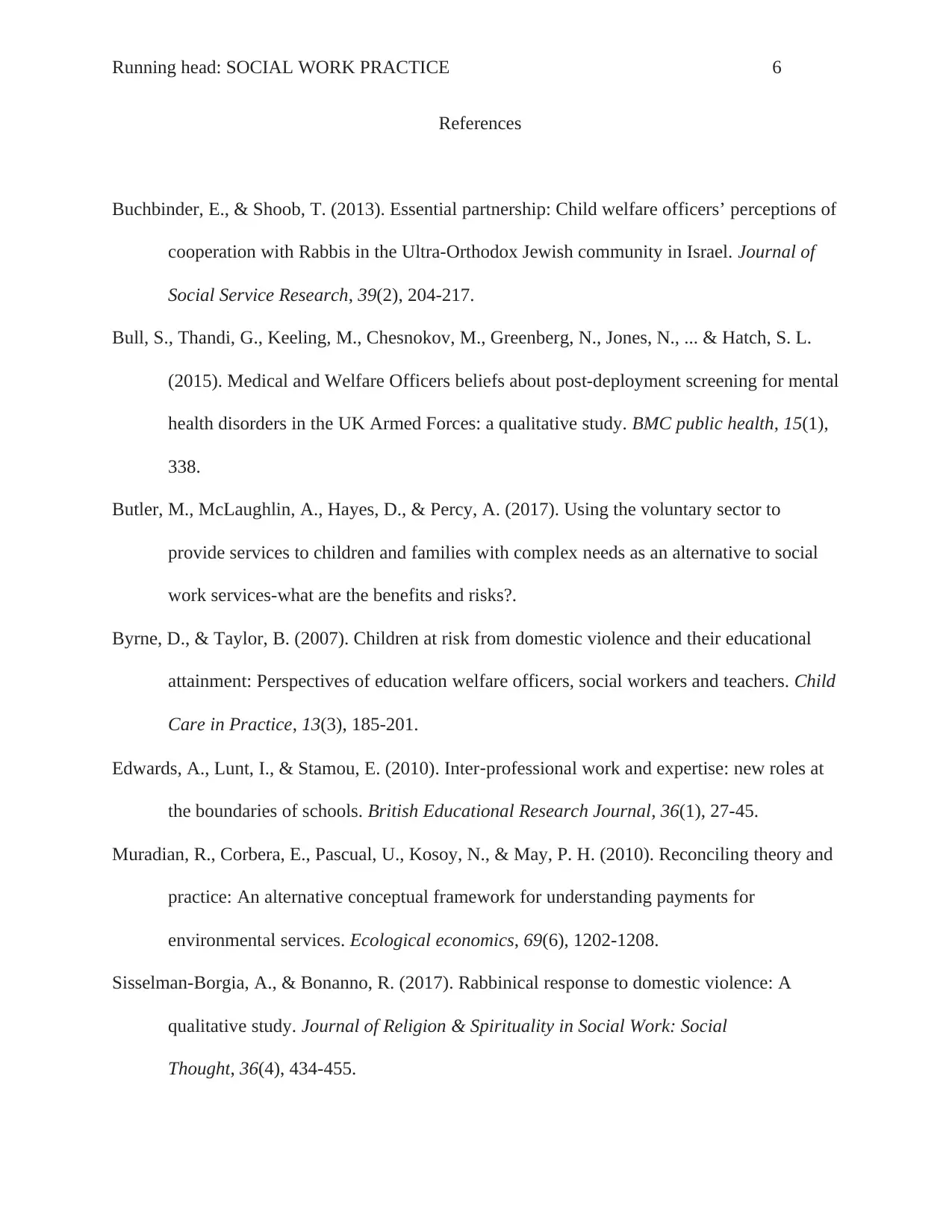
Running head: SOCIAL WORK PRACTICE 6
References
Buchbinder, E., & Shoob, T. (2013). Essential partnership: Child welfare officers’ perceptions of
cooperation with Rabbis in the Ultra-Orthodox Jewish community in Israel. Journal of
Social Service Research, 39(2), 204-217.
Bull, S., Thandi, G., Keeling, M., Chesnokov, M., Greenberg, N., Jones, N., ... & Hatch, S. L.
(2015). Medical and Welfare Officers beliefs about post-deployment screening for mental
health disorders in the UK Armed Forces: a qualitative study. BMC public health, 15(1),
338.
Butler, M., McLaughlin, A., Hayes, D., & Percy, A. (2017). Using the voluntary sector to
provide services to children and families with complex needs as an alternative to social
work services-what are the benefits and risks?.
Byrne, D., & Taylor, B. (2007). Children at risk from domestic violence and their educational
attainment: Perspectives of education welfare officers, social workers and teachers. Child
Care in Practice, 13(3), 185-201.
Edwards, A., Lunt, I., & Stamou, E. (2010). Inter‐professional work and expertise: new roles at
the boundaries of schools. British Educational Research Journal, 36(1), 27-45.
Muradian, R., Corbera, E., Pascual, U., Kosoy, N., & May, P. H. (2010). Reconciling theory and
practice: An alternative conceptual framework for understanding payments for
environmental services. Ecological economics, 69(6), 1202-1208.
Sisselman-Borgia, A., & Bonanno, R. (2017). Rabbinical response to domestic violence: A
qualitative study. Journal of Religion & Spirituality in Social Work: Social
Thought, 36(4), 434-455.
References
Buchbinder, E., & Shoob, T. (2013). Essential partnership: Child welfare officers’ perceptions of
cooperation with Rabbis in the Ultra-Orthodox Jewish community in Israel. Journal of
Social Service Research, 39(2), 204-217.
Bull, S., Thandi, G., Keeling, M., Chesnokov, M., Greenberg, N., Jones, N., ... & Hatch, S. L.
(2015). Medical and Welfare Officers beliefs about post-deployment screening for mental
health disorders in the UK Armed Forces: a qualitative study. BMC public health, 15(1),
338.
Butler, M., McLaughlin, A., Hayes, D., & Percy, A. (2017). Using the voluntary sector to
provide services to children and families with complex needs as an alternative to social
work services-what are the benefits and risks?.
Byrne, D., & Taylor, B. (2007). Children at risk from domestic violence and their educational
attainment: Perspectives of education welfare officers, social workers and teachers. Child
Care in Practice, 13(3), 185-201.
Edwards, A., Lunt, I., & Stamou, E. (2010). Inter‐professional work and expertise: new roles at
the boundaries of schools. British Educational Research Journal, 36(1), 27-45.
Muradian, R., Corbera, E., Pascual, U., Kosoy, N., & May, P. H. (2010). Reconciling theory and
practice: An alternative conceptual framework for understanding payments for
environmental services. Ecological economics, 69(6), 1202-1208.
Sisselman-Borgia, A., & Bonanno, R. (2017). Rabbinical response to domestic violence: A
qualitative study. Journal of Religion & Spirituality in Social Work: Social
Thought, 36(4), 434-455.
⊘ This is a preview!⊘
Do you want full access?
Subscribe today to unlock all pages.

Trusted by 1+ million students worldwide
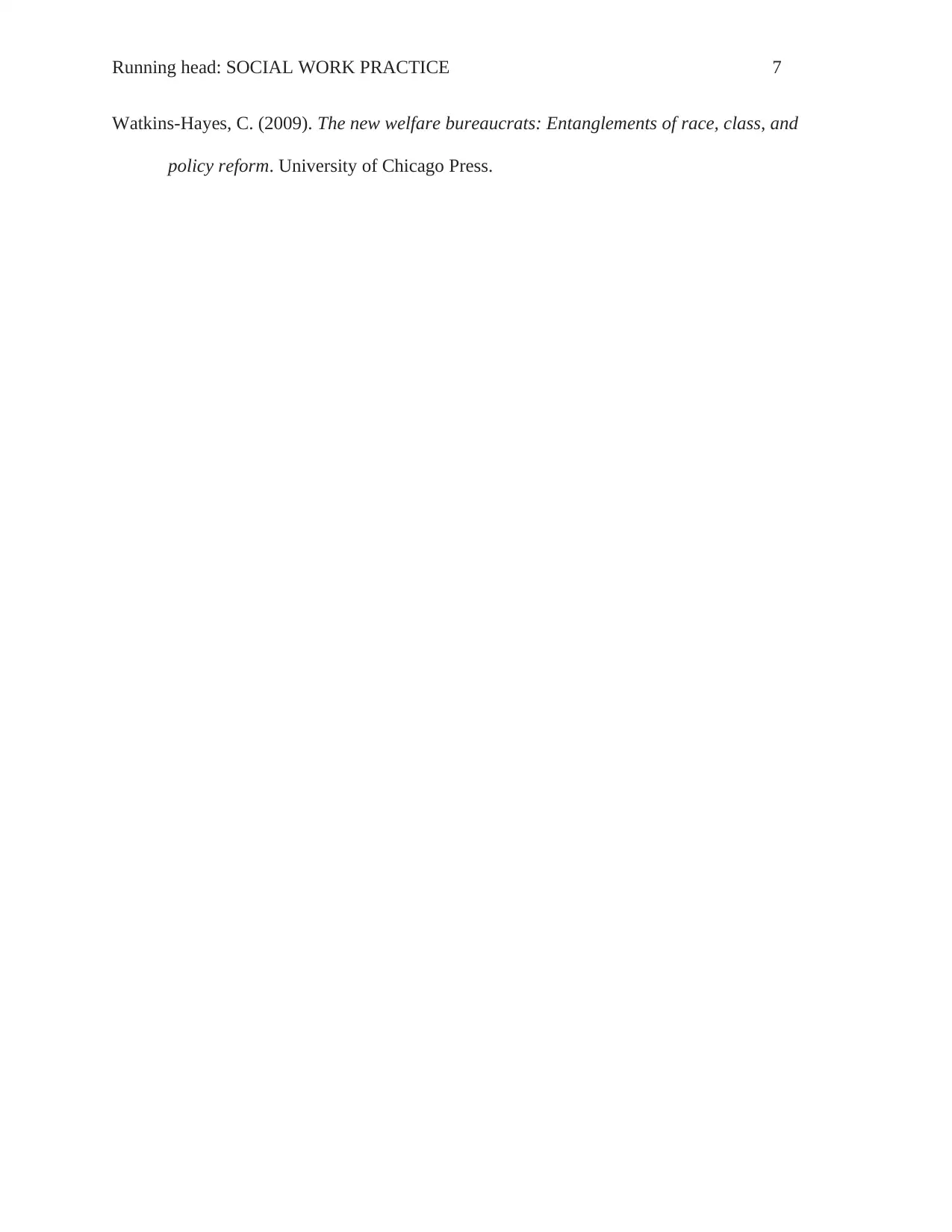
Running head: SOCIAL WORK PRACTICE 7
Watkins-Hayes, C. (2009). The new welfare bureaucrats: Entanglements of race, class, and
policy reform. University of Chicago Press.
Watkins-Hayes, C. (2009). The new welfare bureaucrats: Entanglements of race, class, and
policy reform. University of Chicago Press.
Paraphrase This Document
Need a fresh take? Get an instant paraphrase of this document with our AI Paraphraser

Running head: SOCIAL WORK PRACTICE 8

Running head: SOCIAL WORK PRACTICE 9
⊘ This is a preview!⊘
Do you want full access?
Subscribe today to unlock all pages.

Trusted by 1+ million students worldwide
1 out of 9
Related Documents
Your All-in-One AI-Powered Toolkit for Academic Success.
+13062052269
info@desklib.com
Available 24*7 on WhatsApp / Email
![[object Object]](/_next/static/media/star-bottom.7253800d.svg)
Unlock your academic potential
Copyright © 2020–2025 A2Z Services. All Rights Reserved. Developed and managed by ZUCOL.





